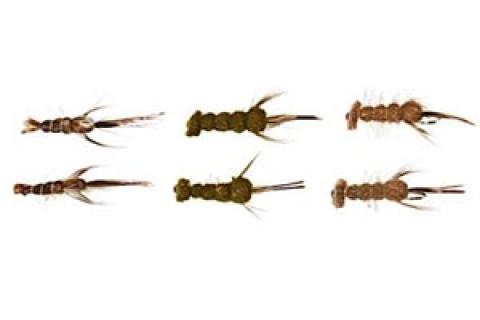
Minnows may be the staple food for bass, and insects are clearly the bread and butter diet for trout. But if you show either of these popular gamefish a crayfish, they'll gobble it up in a flash. There seems to be something about the taste appeal of these crustaceans that bass, trout and also walleyes, pike and panfish, find irresistible.
 |
| The Clouser Crayfish is one of the most popular crayfish fly patterns of all time. |
Crawfish, crayfish or crawdads are all the same, there is no biological or physiological difference between them. These tastey crustaceans resembling small lobsters aren't necessarily just an occasional treat for gamefish, either. In some waters they are quiet abundant and form a major item on the fish's diet. Over 500 species of crayfish exist worldwide, and more than 100 inhabit the United States and Canada. They are found in streams, rivers, lakes and ponds.
Crayfish (or crawdads) eaten by gamefish typically range from 1-3 inches. Colors vary but shades of brown, gray, tan, olive and rust seem most common. Years ago only a handful of crayfish patterns could be found. Today there are a number of good crayfish flies as well as several patterns that can serve double-duty as crawdad imitations.
How to Fish Crayfish Flies
Crayfish are somewhat nocturnal creatures, so action with these flies is often particularly good early and late in the day and when cloud cover is heavy. Also keep in mind that crayfish are bottom-dwellers. Flies should be kept within a foot or so of the lake or river floor. Many patterns are weighted to take them deep quickly. You can also add split shot or use a sinking tip or full sinking line for fishing deep lakes and big rivers.
Keep leaders short, so they don't lift the fly off the bottom — 4-6 feet is sufficient. Tippet test will vary with the size fly being used and fish sought, as well as how much cover is available for fish to wrap your leader around during the fight. You may need anywhere from 4-12 pound test. Avoid going too light, though. It can cause twists in the leader when you cast.
Most anglers are familiar with the backwards, spurting motion of crayfish. That is one type of movement they display, often when they are alarmed and trying to flee. Crayfish also move in a slower, less frenetic manner, though, as they crawl forward searching for food or simply moving about.
Keep both of these styles of movement in mind when fishing crawdad patterns. Try darting spurts of 4-12 inches followed by pauses, and also a steady crawling presentation using a hand-twist retrieve.
Where to Fish Them
Work crayfish flies around rocks, logs, ledges and bottom debris in rivers. Also probe tail-outs of pools, shoreline edges and backwater eddies. In lakes fish near points, weed beds, feeder creeks, coves and shoals. Don't be surprised if the biggest fish of your life falls for one of these miniature lobsters.
Pattern Options
Crayfish patterns have been made with hackle, rabbit skin and fur, deer hair, closed-cell foam, artificial leather, real leather and synthetic fur. One of the most popular patterns of all is the Clouser Crayfish. It has a thick fur underbody with feather claws, wound hackle for legs and a dark feather section for the back ribbed with monofilament. In a pinch, various Sculpin patterns or a Wooly Bugger will work well as crayfish imitations if you don't have specific crawdad flies in your box.
- 10921 views

